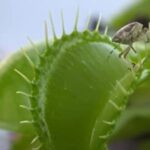As an Amazon Associate, this site earns commissions from qualifying purchases. For more details, click here.
If you visit nurseries you will see loads of Venus flytraps encased in plastic or glass containers. When you buy one of these plants they are probably encased, so should you keep them there? If you are thinking of buying a Venus flytrap, please read this guide first.
A plastic or glass cover will cause overheating and harm Venus flytraps. If the plant came in a covered case, lift the lid a few hours a day until the Venus flytrap is used to the humidity, then you can discard the lid.
How to Remove Covers on New Venus Flytraps
If you bought a Venus flytrap in a lid covered case, you will have to remove it. However this needs to be done properly otherwise it could harm the plant.
First thing you need to do is lift the lid over a one week period. Raise it each day for an hour so the plant can get used to the humidity. Increase its humidity exposure to three hours, then five and so on.
That Venus flytrap has probably spent most if not all of its life under a lid, so it needs time to acclimatize to the temperature and environment.
You need to be patient with this. After a week you can completely remove the lid and expose the Venus flytrap to light.
Venus flytraps need 6-12 hours of light. Direct sunlight is fine as long as the temperature does not exceed 95 F (35 C). If it gets too hot, do not put a cover on the plant. If you are going to place the plant outdoors just move it into a shaded location where it can still get indirect sunlight.
Natural light is best but artificial light will work too. If you are keeping the plant indoors, place it on a window so it can catch some sun. Use artificial light during overcast days for 12 hours.
Check the Soil and Pot
Some nurseries plant Venus flytraps in regular potting soil, which can kill it. One of the first things you need to do is inspect the soil and if necessary, replace it.
You can use different types of soil for Venus flytraps as long as they are nutrition free. The standard mixture is 1:1 perlite and peat moss. This works not just for Venus flytraps but other carnivorous plants as well.
Once you have the soil ready, repot the plant. There are various Venus flytrap variants and some are larger than others, so make sure the pot is the right size.
A 4 to 6 inch deep pot will be fine. A 4 inch pot is enough to grow most Venus flytraps, but a 6 inch pot is ideal if you are going to sit the plant in water.
Once you have the pot and soil ready, you can repot your Venus flytrap. Should you repot the plant before removing the lid? You should probably repot the plant first. Then let the plant get used to the humidity using the lid removal method given above.
What Happens if You Put a Cover on Venus Flytraps?
Covering Venus flytraps is going to to cause a lot of potential problems, ranging from stunted growth, smaller traps, vulnerability to disease and more. As we mentioned, you have to remove the cover slowly, but it needs to be done.
Overheating
Venus flytraps prefer temperatures somewhere between 70 to 95 F (21 to 35 C). Keep them under a lid and the temperature will climb up especially during summer.
Venus flytraps need sunlight, not heat. Too much heat will dry the soil and these plants require a constantly moist soil. If you let the soil dry it could ne fatal to the plant.
Overheating causes leaves to dry and even burn. They turn black and develop a crispy texture before dying. It will not take long before the rest of the plant is affected.
These problems can be avoided if you don’t cover the plant. As we pointed out, Venus flytraps grow best outdoors , and keeping them under a lid is the exact opposite.
No Insect Food, Smaller Traps
You have probably seen some Venus flytraps kept in a glass bowl or some other fancy container. While they look cool, it will harm the plant in the long term.
If your Venus flytrap is kept under cover, how will it catch insects? Their traps lure and eat bugs for nutrients.
There is no way a Venus flytrap can catch insects if it is covered. The only option is feed them by hand. You can give them dead bugs or freeze dried food . But it is inconvenient to lift the over up repeatedly every time they feed.
These plants will survive without eating bugs, but growth will slow. Its colors will get dull and the traps get smaller. If you add the heat factor and it becomes a very unfavorable condition for any plant, especially Venus flytraps.
Stagnant Air
When we think about Venus flytrap essentials, two things come to mind, sunlight and water. But air is just as crucial.
Venus flytraps kept under cover will result in stagnant air, which can lead to molds and bacteria growth. Bacteria can cause root rot and cause widespread damage.
Plants need fresh air and sunlight to grow. Fresh air also helps fight off excess heat that would otherwise harm the plant.
The problem with fungi, mold and bacterial infection is they do not show symptoms until it has already spread. They thrive in enclose spaces, so lids and covers make Venus flytraps vulnerable to them.
Lack of Space For Roots
Another problem is the lack of space. Imagine a Venus flytrap planted in a small container encased in a glass bowl. It looks great on the outside, but what is actually happening under the soil?
Venus flytrap roots grow and spread just like other plants. They need room to expand, and an enclosed space does not help. Some Venus flytrap roots reach 7 inches in length. Since they grow down, there needs to be sufficient space.
A closed environment is not conducive to plant growth. The roots could get entangled and can lead to all kinds of problems. A large container with circulating air is a better option.
No Water Drainage
A cover also means problems with water drainage. The last thing you want is stagnant water as it can bring all kinds of trouble not just for your plant but your home.
As you can see here, there are a lot of reasons not to keep Venus flytraps under cover. While it does look good, the potential list of problems is too numerous. Better to just leave the plant outdoors or indoors cover free. And when your Venus flytrap starts growing healthy traps, you will be happy you got rid of the cover.
Tips for Venus Flytrap Care
- Do your research first. A lot of potential problems can be avoided if you know what steps to take. Do some research on the variant you want to buy. There is plenty of information here to help you grow Venus flytraps the right way.
- Do not touch the traps. If you want to see the flytrap eat, give it a dead bug, fish food or freeze dried mealworm and cut them into small pieces. Place it in one of the traps (2/3 filled maximum) and tap the hair trigger twice.
- Do not touch the trap to see if it bites you. Venus flytraps cannot bite you and you will just waste its energy.
- It is normal to see individual traps wither and die. Each one can close up to five times before turning black and dying. Do not worry as it will be replaced by another one.
- No steak. Venus flytraps sometimes lose leaves after eating a large meal. But the plant will not die after eating. Feeding it processed meat however, could damage the plant.
Conclusion
Venus flytraps are not hard to grow despite the prevailing myth. However you need to handle them the right way. Aside from watering, sunlight and soil, you also have to make certain it is in the right environment, and that means no cover.

My fascination with carnivorous plants began many, many years ago with Venus Fly Traps. Now I am more than happy to impart what I know with other enthusiasts and those who are curious about meat eating plants.



